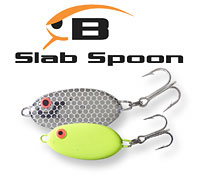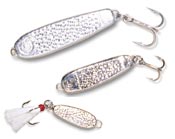Re: Does anyone striper/white bass fish in Indiana
Happens a lot on the lakes here, seems to be harder to get bit by suspended fish than the ones on the bottom at 20-30 feet.<br /><br />We use slabs, like these made by one of the six old geezers on Lake Texoma:<br />
www.sixoldgeezers.com/ad.htm<br /><br />I haven't tried prunepicker's, usually I find some in the tackle shop of that general shape & size. Best luck has been on chartreuse/white, also white with holographic reflective tape. Bomber Lures Slab Spoon is the only big name brand I've seen comes close to the right shape.<br /><br />Vertical presentation, just lift & let drop. Vary the pattern 'til you get bit, from big jerks, 3 or 4 feet at a time, to just barely dunking 'em. 3/4 or 1 oz. will sink about a foot per second.<br /><br />Sometimes a chrome hopkins spoon does the trick.<br /><br />Also sometimes a 4 inch sassy shad white or pearl or chartreuse on a 3/4 or 1 oz. jig head, or a 4 inch Storm wildeye swim shad, chartreuse/silver, very slow retrieve, they got a pretty good sink rate, too.<br /><br />Last but not least, if you're marking fish that aren't biting, this usually gets 'em (but not so much in the wintertime):<br /><br />
Hell Pet rig <br /><br />It's a Hellbender with hooks removed & a 3/4 oz. weight added, followed by a 4 foot leader & #12 pet spoon. Troll it at 2-3 mph 75 or 80 feet behind the boat, runs about 17 feet deep, deeper with small diameter braided line, a little less with 17 lb mono. Run it throught the school & you should hook up on every pass. If you don't, then let more line out, or vary the speed a bit. If you don't get a bite on 3 or 4 passes then move on, don't waste your time & gasoline. This is mostly effective in the spring & summer; fall & winter almost always require vertical presentation. <br /><br />Hellbender color (silver or white) doesn't seem to matter; neither does the color of the feather on the spoon. But it does seem to need to be a pet spoon. Academy Sports has a cheaper knock-off that works just as well, but the little screw holding the hook in comes out after a dozen fish or so, so now I take it out & put it back in with loc-tite. <br /><br />Some people have reported success using a DB22 in place of the hellbender, I haven't tried it. Or a 3-way swivel with a DB22 followed by a pet spoon. I mostly prefer not to troll, though, because I'd rather fight the fish than the hellbender.<br /><br />As far as finding 'em, if I notice a hump, say, 10 feet shallower than the surrounding water I'll usually stop & look for bait on the graph. If I see it I'll fish it for a little while since sometimes whites will hug the bottom so close they don't show up on the graph. Fish the edges & across the top. Same if you find a point that comes way out into the lake. <br /><br />Also, you may already know about this, but if you see a flock of birds with tailfeathers pointed at the sky, fish under 'em. Sea gulls is the bird of choice around here, but sometimes we catch 'em under pelicans or terns or water turkeys (some kind of loon-looking swimming bird that dives underwater).<br /><br />When a shad gets threatened, it tries to hide in the center of the school, so as each one tries to get to the middle they get tighter and tighter. Finally a predator will just slash through the middle, like a cue ball on the break, wounding & disorienting a bunch of 'em, which just flutter down, which explains the effectiveness of jigging a slab. I've actually watched this happen on my fishfinder, you see a sort of thumbprint with diagonal lines slashing through the middle.<br /><br />A dying shad sort of lies on the bottom attempting to swim but not getting very far, the wave action pushing it back & forth, which is what a slab barely bounced off the bottom looks like, or drifting a wildeye on the bottom.<br /><br />As far as "jumps," (we call it "schooling") that usually happens in the summertime, rarely this early in the year, but it happens every year. Sometimes if the water level gets way up they'll feed shallow without breaking the surface, makes me think maybe it's more about how far from the bottom the shad will go to get away from 'em. I know people say the bigger ones are underneath, but I'm a sucker for a big splashy topwater strike, and my fish aren't usually smaller than anybody elses. But usually anything shiny will draw a strike in a feeding frenzy.<br /><br />Long post, don't know if any of these techniques will work on your lakes, there's at least a dozen big impoundments within 100 miles of here, three of which I fish regularly, & the same stuff usually works on all of 'em. Sometimes have to vary the size or shape of the lures.<br /><br />Have fun & post your results!





















